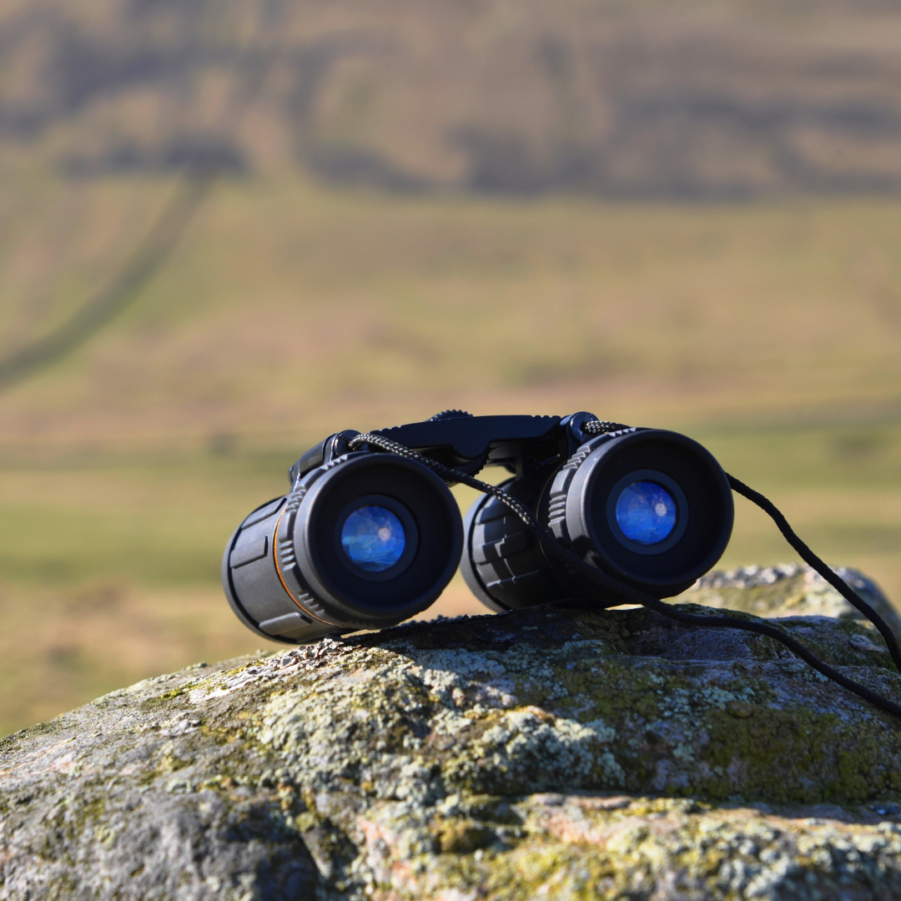For me, choosing my first pair of binoculars was a major first step in my naturalist journey. They opened up a whole world of nature and let me get a closer look at all kinds of wildlife. However, getting started with a pair of binoculars can be daunting. There are loads of different options and a massive price range, and it’s hard to know where to start. This post will give you the tools you need to choose a pair of binoculars that fits your needs. Specifically, I connect types of binoculars to the activities for which they work best, whether you’re going on safari on watching your birdfeeder.
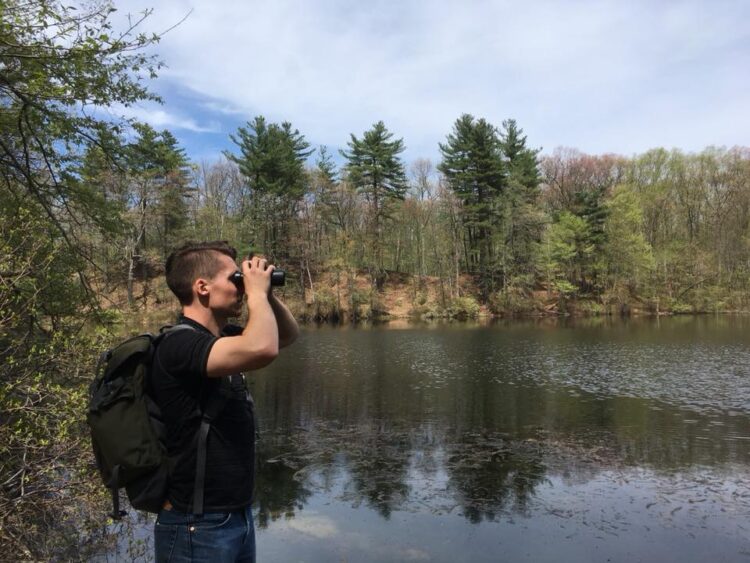
What do those numbers mean?
One of the most intimidating things about buying a pair of binoculars is the mysterious pair of numbers in their name. Just a quick look around a typical website brings up 8×42, 12×50, 8×25, and many more. But what do those numbers mean, and how can they help you choose a pair of binoculars?
Magnification
The first of those two numbers is the magnification. In other words, how many times bigger or closer an object appears when you look at it. The higher the number, the higher the magnification and the closer (or larger) an object will appear. If the magnification is 12x, then the object will appear 12-times closer!
Higher magnification means you can see stuff from further away. This gets you a more detailed view of your target, a real “closer look”. However, higher magnification binoculars require more experience to use effectively. When you zoom in more rather than less, it can be harder to find things that were easy to see with your naked eye. In other words, you can get “lost” in your zoomed-in world. Check out my guide on how to use binoculars to avoid this problem.
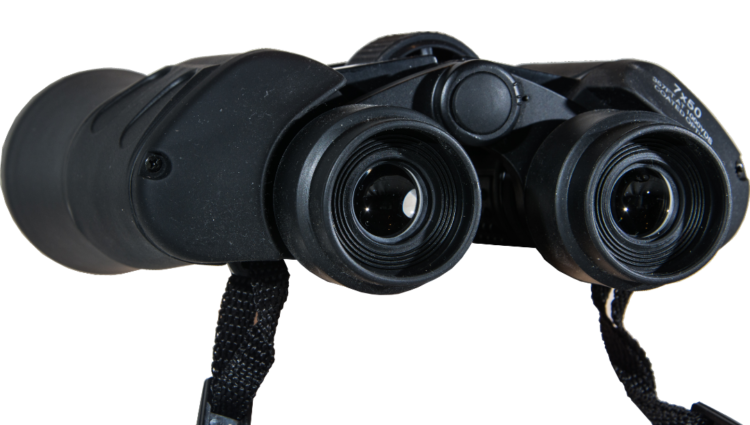
Higher magnification also requires steadier hands, since the more you zoom in, the more difference any small movement makes. Ultimately, any twitch or tremble can make a lot of movement in your field of view at higher magnification. If you’re likely to be moving around a lot, or can be a little shaky, lower magnitude binoculars may be better.
Size or Diameter
The second number is the size or diameter, which is measured in millimeters. It represents the diameter of the objective lens, which is the part of the binoculars that concentrate light. This determines how big of a field of light the binoculars take in. Combined with the magnification (above), the binocular size determines the field of view.
Field of View
Simply put, the field of view is the amount of space visible when you look through the binoculars. A larger diameter objective lens means you can see a larger space. However, there is a tradeoff between magnification and lens size. Higher magnifications (zooming in more) mean you have a smaller field of view. Although this makes intuitive sense, you can test it out with a phone camera. When you zoom in on an object, you see less of the surrounding area.
Why do some binoculars look so different?
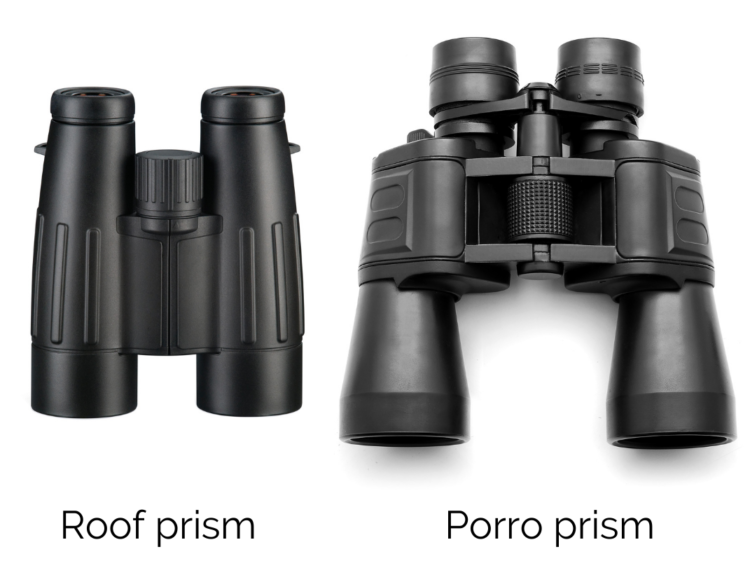
Have you ever noticed how some binoculars have different shapes? Specifically, sometimes the eyepieces are directly in line with the main lenses (the big ones at the front). This is common for compact binoculars. Meanwhile, other binoculars have the main lenses set wider than the eyepieces. These dramatically different shapes have to do with the arrangement of the prisms that make them function.
The former, more compact example use what are called roof prisms, and the bigger ones use Porro prisms. Ultimately, this just describes how they reflect and change the light that passes through them. Generally speaking, Porro prism binoculars have a better image. On the other hand, they are bulkier and take up more space, and can weigh more. Achieving the same quality of image as a Porro prism with a roof prism pair of binoculars is often more expensive.
Warranty
It’s also a good idea to pay careful attention to the warranty on a pair of binoculars. This is especially true if you buy a more expensive or sophisticated pair. Additionally, you’ll want a good warranty if your binoculars will be coming on more strenuous adventures where the risk of damage is greater.
Choosing your binoculars
Binoculars come in handy for all kinds of outdoor adventures. However, which binoculars work best for you will depend on how, and where, you want to use them. For example, binoculars with a very narrow field of view may be difficult for beginning birdwatchers to use. On the other hand, they might be great for stargazing, where your target doesn’t move around.
Check out the following sections for info on what types of binoculars to consider for different activities. I have also provided links to binoculars that are a good fit for these activities across different price ranges. These are certainly not all of the available options out there. In fact, I’m sticking mostly to brands that I have tried in the field or at sporting goods stores. Additionally, I’ve included some models that friends have used and recommended. Check it out!
Birdwatching
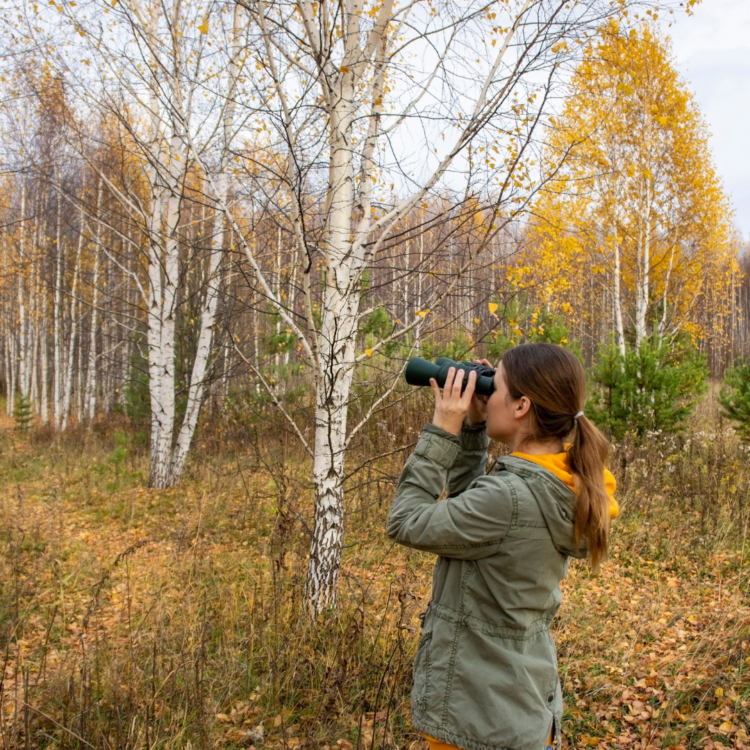
Birdwatching requires a lot of versatility in your binoculars. Some days, you might find yourself in dense forest, and others in an open park. People will go on long treks for birdwatching, while many others just watch birds in our backyards. Consequently, binoculars are most appropriate for birdwatching will depend on the type of birdwatching.
For backyard or birdfeeder birdwatching, birds will probably be pretty close at hand. Since you’re covering a smaller amount of area, you don’t need a huge field of view. Backyard birding is also less likely to involve long hours of walking, so the weight of your binoculars might not be a big deal.
If you’re on a budget, heavier but less expensive binoculars using Porro prisms are probably a great way to go for this type of birding. They’re less expensive but their greater weight doesn’t matter. You can also get away with lower magnification and smaller lens size, since the birds will be relatively close. I would recommend 8x, or at most 10x, magnification for backyard use.
Weight is more of an issue for more active birdwatchers. This is especially true where when birdwatching involves long hours of walking or driving. Although most birdwatchers typically stick to an 8x or 10x magnification, they will look for a larger diameter lens.
Additionally, since you don’t want heavy binoculars weighing you down all day, people look for lighter options. 10×42 or 8×42 roof prism binoculars are the most typical ones I see out in the field. They are a bit more pricey, but lighter weight, compact, and have just enough magnification to be helpful and versatile.
Binoculars to choose for backyard birdwatching
On a budget

Celestron Cometron 7×50 – A big field of view and moderate zoom, great for beginning birdwatchers. Also about as cheap as you’ll want to get for a decent pair. Binoculars below $30-40 tend to get pretty unreliable.

Middle of the road


Nikon 8252 Aculon A211 10-22×50 – Note the zoom feature here! This can be great if you’re stationary but looking at wildlife in different parts of your yard. These bulkier Porro prism binoculars get your more bang for your buck but are definitely better for limited travel use.
Binoculars to choose for mobile bird watchers
On a budget

Celestron Outland X 10×42 – A cheaper roof prism pair that allows greater mobility and portability with decent performance.
Middle of the road

Nikon 7576 Monarch 5 8×42 – These are my go-to recommendation for people who are starting out their birding path. They’re sturdy, reliable, and have excellent optics for a very reasonable price. I currently carry a pair of these around with me on all of my naturalist walks.

Seriously fancy

Swarovski 8.5×42 EL – We’re talking the sports cars of binoculars now. Incredible image quality, fabulous design, all the moving parts move right. These are fantastic and versatile binoculars if you can afford the price tag.

Leica Geovid 8×42 – Leica has some of my favorite binocular designs out there. They’re simple, no-frills, but super-duper high quality. As with other binoculars at this level, you’re definitely getting what you pay for.

Zeiss 8×42 Victory SF Probably my favorite binoculars of all time. A sleek build with sturdy moving parts and smooth operation. Mind you, I’ve only tried someone else’s, but I’m a giant fan of this model. A bit outside of my price range, but absolutely worth the investment for a serious naturalist.
Backpacking & Hiking
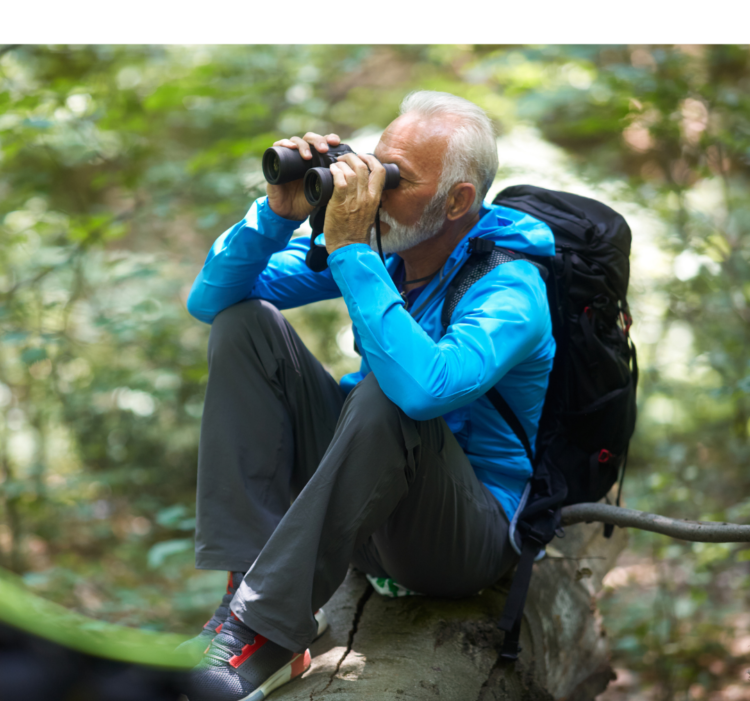
Minimizing weight is the biggest concern for backpackers. The further you’re going, the more important this becomes. Every additional ounce can be a concern when you’re going tens, hundreds, or even thousands of miles. As a result, smaller, more compact, and lighter binoculars are by far the best choice for backpackers and hikers.
Even with a relatively compact 8×42 pair that I use for birdwatching, I feel weighed down after more than 5 or 6 miles. The best way to reduce size and weight is to look for roof prism binoculars with smaller diameter lenses.
If you’re planning a long ridgeline hike in an area with few trees like the American rockies, the Alps, or the Andes, a higher magnification might be useful. With a 10x or 12x magnification, you will be able to admire wildlife at the greater distances at which you may be seeing them. By contrast, if you’ll be walking in heavily forested areas like the Appalachian trail, a lower magnification like 8x might be a better idea.
Binoculars to choose for backpacking & hiking
On the cheaper side

Bushnell H20 Waterproof Compact 8X25

Pentax UP 8-16×21 – These have a helpful zoom feature. although you sacrifice some quality, the range in magnification can be helpful if you’re hiking through different environments.
Middle of the road

Nikon Sportstar Zoom 8-24×25 – These binoculars have a zoom function which allows some versatility if you’ll be hiking through different kinds of habitat. That may come with a slightly lower image quality, but the added flexibility can come in handy.

High end

LEICA Trinovid HD Lightweight Compact


Safaris & Whale watches
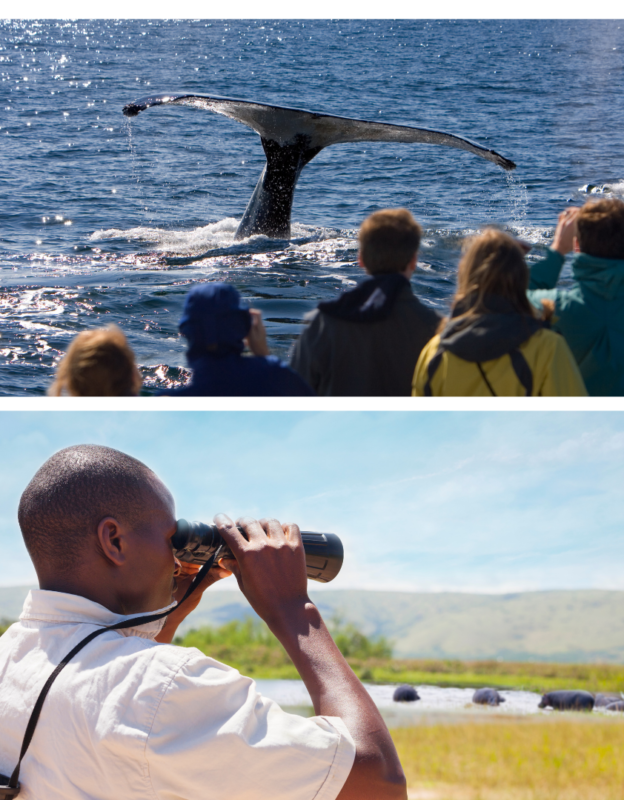
The size or heft of your binoculars may be less of an issue when you’re in a vehicle and not lugging them around. If you’re watching wildlife from a boat or a safari truck, bulkier binoculars might not be such an issue. So binoculars with Porro lenses are a great way to go. Larger diameter lenses are also a great idea, since you can get a bigger field of view for a given magnification.
Since you’re already looking at a bigger field of view and the size of the binoculars don’t matter, higher magnifications aren’t a bad idea either. Binoculars with multiple levels of magnification might work well, too, provided that the quality of the lens is still high. This type of binocular has a sort of “zoom” function that allows you to change the magnification.
Binoculars to choose for safaris & whale watches
On a budget

Celestron Skymaster 25×70 – A high magnification and a big field of view for watching wildlife in large spaces at a moderate price. You’ll want to prop them up on something to keep steady, these are heavy with a big magnification!
Middle of the road

Top of the line

Fujinon Polaris 16×70 FMT – These are super durable binoculars with extremely high-quality optics, a pretty high magnification, and a massive field of view. Perfect for a safari or whale-watch where you’re not moving much but wildlife are potentially far away. I wouldn’t want to lug these around on a hike, but it would be great to have them in my lap on a traveling adventure.
Some final thoughts on how to choose binoculars
It’s always a good idea to try out a couple pairs of binoculars before buying them. If you haven’t already, check out my post on how to use binoculars to get to know how they work. Where possible, you may also want to try borrowing a friend’s binoculars to get a feel for them. Your binoculars will be a nature companion for years to come. Because of that, it’s worth being deliberate when you choose a pair of binoculars.
Thanks for reading!
Did you find this post helpful? Do you have other suggestions for choosing a pair of binoculars? Let me know in the comments! If you enjoy the blog or have other topics that you would like to see covered, get in touch using the contact page.

